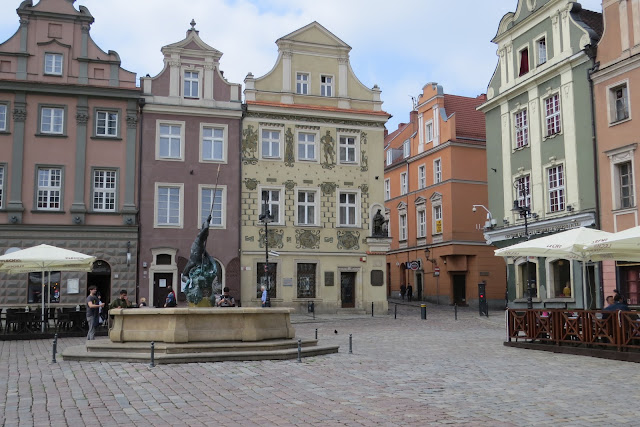POZNAN
Wednesday
22 May
 Early breakfast,
then off to Poznan in Poland,half way between Berlin and Warsaw. Crossed Oder river into Poland around 9:30am
and stopped in Poznan for lunch. We all
scattered to choose a café and were
warned to ask for the bill in advance as we only had 2 hours. Our café was understaffed and the 5 tourists
who chose it had a long wait for menus and food. The food was OK but the most interesting
aspect was the underground bar with amusing signs on the toilets.
Early breakfast,
then off to Poznan in Poland,half way between Berlin and Warsaw. Crossed Oder river into Poland around 9:30am
and stopped in Poznan for lunch. We all
scattered to choose a café and were
warned to ask for the bill in advance as we only had 2 hours. Our café was understaffed and the 5 tourists
who chose it had a long wait for menus and food. The food was OK but the most interesting
aspect was the underground bar with amusing signs on the toilets.
 |
| Stanislaus was the last king of Poland, abdicating in 1795. |
 |
| Executioner or monk? |
|
|
|
 |
| Photo opportunity |
WARSAW
Warsaw seems to be a city under perpetual building and restoration.
Most of it was razed in WW2 but residents started rebuilding as soon as
they returned, using much of the material on site.
 |
| Sigismund's Column, originally erected in 1644, is located in Castle Square |
|
|
|
|
 |
| Brackets at Warsaw university |
|
 |
| Marshall Pilsudski |
This amazing man was a socialist revolutionary who engineered Polish
independence in 1918 and became head of state. He then successfully
defended Poland against the Russian Red Army.
 |
| Chopin Monument next to the Botanical Garden in Łazienki Park |
 |
| Above and below: at the Museum of History of Polish Jews |

1.8 to 1.9 million Polish civilians (non-Jews) and 3 million Polish
Jews were victims of German Occupation policies and the war.
 |
| Memorial to those killed by Russians or sent to Russian labour camps |
 |
| Presidential Palace - in front, a group of demonstrators |
 |
| Copernicus, 1830 bronze |
Soon after the Nazi German occupation of Warsaw in 1939, the Germans effaced the Latin and Polish inscriptions and attached a plaque in German language: "To Nicolaus Copernicus [from] the German Nation".... After the Warsaw Uprising, in which the monument was damaged, the Germans decided to melt it down. They removed it to Nysa,
but had to retreat before they could melt it down. The Poles brought
the monument back to Warsaw on 22 July 1945, renovated it, and unveiled
it again on 22 July 1949. (Wikipedia)
Artisans in one street showcased their offerings by painting scenes.
 |
| Shoemakers and animals providing leather |
 |
| Palace of Culture and Science, Art Deco Stalinist, 231m, tallest building in Poland |
Friday 24 May
Our next stop was Częstochowa, 220km from Warsaw, and famous for Jasna
Gora monastery. It is devoted
to worship of the "Black Madonna", an icon dating back to 13th
C.
In 1430 the icon was attacked and 4 diagonal slashes on the right
cheek are still visible after restoration. In 1656 King John Casimir
appointed the 'Blessed Mother' Queen of Poland. Pope John Paul 11, President
Kennedy and many others revere this icon. Pilgrims walk around the altar
on hands and knees. 11,000 votive offerings have been made.
The icon
is 'dressed' in a ruby or diamond frame on most occasions, but other dresses
have been made. It is set on an ebony altar.
Mass was
in progress when we entered. Pilgrims
may follow the same route around the icon as we did, but on their knees.
 |
Entrance gate
|
 |
Monastery tower
|
 |
Road up to the monastery
|
Auschwitz
is 86km from
Częstochowa, a bleak contrast to the grandeur of Jasna Gora. Here we were confronted with many photographs,
artefacts and buildings, all testifying to the horror Jews and others suffered. Most poignant for me were the faces of
children, bewildered, wondering what was happening. There was no mercy for them. Also chilling
was the room full of human hair and a big carpet made from it. Our guide
commented that the wife of the camp commandant found it the best place she’d
ever lived in. Her large house did not
overlook the camp.
 |
Boarding a train
|
 |
Sorting goods
|
 |
Shoes left on the 'shelves' when the Allies arrived
|
 |
Inmates were separated according to sex and ethnicity
|
 |
Gas chamber
|
 |
Ovens
|
 |
Execution wall
|
 Early breakfast,
then off to Poznan in Poland,half way between Berlin and Warsaw. Crossed Oder river into Poland around 9:30am
and stopped in Poznan for lunch. We all
scattered to choose a café and were
warned to ask for the bill in advance as we only had 2 hours. Our café was understaffed and the 5 tourists
who chose it had a long wait for menus and food. The food was OK but the most interesting
aspect was the underground bar with amusing signs on the toilets.
Early breakfast,
then off to Poznan in Poland,half way between Berlin and Warsaw. Crossed Oder river into Poland around 9:30am
and stopped in Poznan for lunch. We all
scattered to choose a café and were
warned to ask for the bill in advance as we only had 2 hours. Our café was understaffed and the 5 tourists
who chose it had a long wait for menus and food. The food was OK but the most interesting
aspect was the underground bar with amusing signs on the toilets.


























































No comments:
Post a Comment